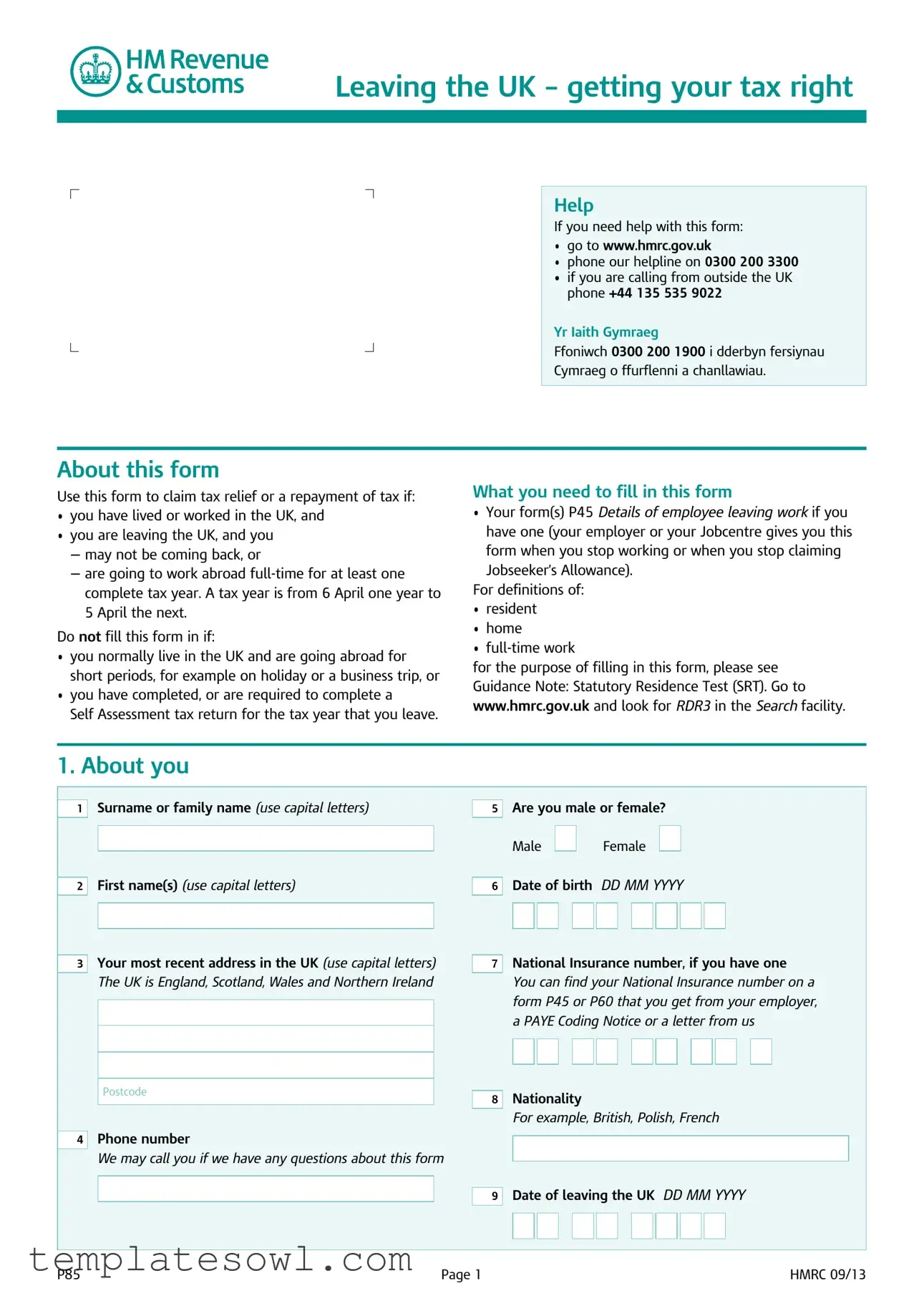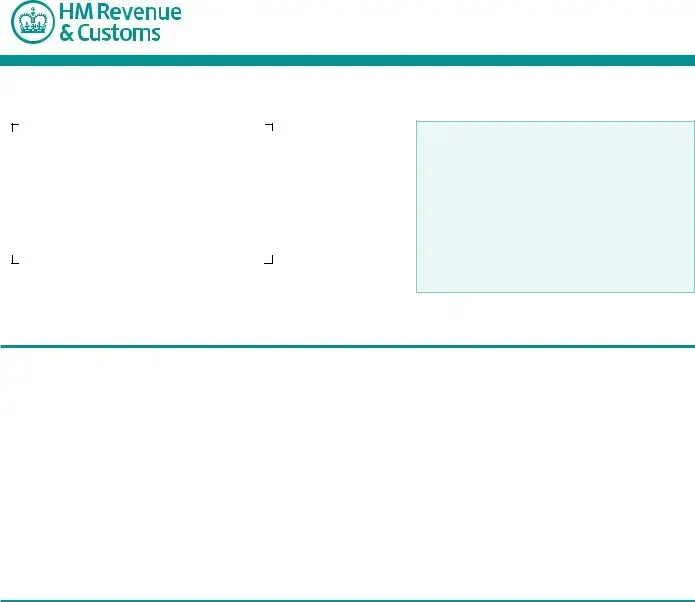Leaving the UK – getting your tax right
Help
If you need help with this form:
• go to www.hmrc.gov.uk
• phone our helpline on 0300 200 3300
• if you are calling from outside the UK phone +44 135 535 9022
Yr Iaith Gymraeg
Ffoniwch 0300 200 1900 i dderbyn fersiynau
Cymraeg o ffurflenni a chanllawiau.
About this form
Use this form to claim tax relief or a repayment of tax if:
•you have lived or worked in the UK, and
•you are leaving the UK, and you
—may not be coming back, or
—are going to work abroad full-time for at least one complete tax year. A tax year is from 6 April one year to 5 April the next.
Do not fill this form in if:
•you normally live in the UK and are going abroad for short periods, for example on holiday or a business trip, or
•you have completed, or are required to complete a
Self Assessment tax return for the tax year that you leave.
What you need to fill in this form
•Your form(s) P45 Details of employee leaving work if you
have one (your employer or your Jobcentre gives you this form when you stop working or when you stop claiming Jobseeker’s Allowance).
For definitions of:
•resident
•home
•full-time work
for the purpose of filling in this form, please see Guidance Note: Statutory Residence Test (SRT). Go to www.hmrc.gov.uk and look for RDR3 in the Search facility.
1. About you
|
Surname or family name (use capital letters) |
|
|
|
Are you male or female? |
1 |
|
5 |
|
|
|
|
|
|
|
|
Male |
|
|
|
|
Female |
|
|
|
|
|
|
|
|
|
|
|
|
|
|
|
|
|
|
|
|
|
|
|
|
|
|
|
|
|
|
|
|
First name(s) (use capital letters) |
|
|
|
Date of birth |
DD MM YYYY |
2 |
|
6 |
|
|
|
|
|
|
|
|
|
|
|
|
|
|
|
|
|
|
|
|
|
|
|
|
|
|
|
|
|
|
|
|
|
|
|
|
|
|
|
|
|
|
|
|
|
|
|
|
|
|
|
|
|
|
|
|
Your most recent address in the UK (use capital letters) |
|
|
|
|
|
|
|
|
|
|
|
|
|
|
|
|
|
|
|
|
|
|
|
|
|
|
|
National Insurance number, if you have one |
3 |
|
7 |
|
|
The UK is England, Scotland, Wales and Northern Ireland |
|
|
You can find your National Insurance number on a |
|
|
|
|
|
|
|
form P45 or P60 that you get from your employer, |
|
|
|
|
|
|
|
|
|
|
|
|
|
a PAYE Coding Notice or a letter from us |
|
|
|
|
|
|
|
|
|
|
|
|
|
|
|
|
|
|
|
|
|
|
|
|
|
|
|
|
|
|
|
|
|
|
|
|
|
|
|
|
|
|
|
|
|
|
|
|
|
|
|
|
|
|
|
|
|
|
|
|
|
|
|
|
|
|
|
|
|
|
|
|
|
|
|
|
|
|
|
|
|
|
|
|
|
|
|
|
|
|
|
|
|
|
|
|
|
|
|
|
|
|
|
|
|
|
|
|
|
|
|
|
|
|
|
|
Postcode |
|
|
|
|
Nationality |
|
|
|
|
|
|
|
|
|
|
|
|
|
|
|
|
|
|
8 |
|
|
|
|
|
|
|
|
|
|
|
|
|
|
|
|
|
|
|
|
|
|
|
|
|
|
|
|
|
|
|
|
|
|
|
|
|
|
|
|
|
|
For example, British, Polish, French |
4 |
Phone number |
|
|
|
|
|
|
|
|
|
|
|
|
|
|
|
|
|
|
|
|
|
|
|
|
|
|
|
|
|
|
|
|
|
|
|
|
|
|
|
|
|
|
|
|
|
We may call you if we have any questions about this form |
|
|
|
|
|
|
|
|
|
|
|
|
|
|
|
|
|
|
|
|
|
|
|
|
|
Date of leaving the UK DD MM YYYY |
|
|
|
|
|
|
|
|
|
|
|
|
|
|
|
|
|
|
|
9 |
|
|
|
|
|
|
|
|
|
|
|
|
|
|
|
|
|
|
|
|
|
|
|
|
|
|
|
|
|
|
|
|
|
|
|
|
|
|
|
|
|
|
|
|
|
|
|
|
|
|
|
|
|
|
|
|
|
|
|
|
|
|
|
|
|
|
|
|
|
|
|
|
|
|
|
|
|
|
|
|
|
|
P85 |
|
|
Page 1 |
|
|
|
|
|
|
|
|
|
|
|
|
|
|
|
|
|
|
|
|
HMRC 09/13 |

10How long had you lived in the UK before the date you left (or the date you intend to leave)?
11From the 6 April in the tax year you left the UK up to the date you left, were you resident in the UK?
Yes No
12Were you resident in the UK in the tax year before the tax year you left? see example below
Example
Your date of leaving the UK was 10 August 2013
|
|
|
|
|
|
|
|
For question |
|
11 |
use tax year 6 April 2013 to |
5 April 2014 |
|
|
|
|
|
|
|
|
|
use tax year 6 April 2012 to |
For question |
|
12 |
5 April 2013 |
|
|
|
|
|
|
|
|
|
|
|
Yes |
|
No |
|
|
|
|
|
|
|
|
|
13How many days do you expect to spend in the UK between your date of leaving the UK and the following 5 April?
days
14How many days do you expect to spend in the UK in each of the next three tax years?
(From 6 April one year to 5 April the next) For example, 81 days between 6 April 2014 and 5 April 2015
Year 1 |
days |
|
|
Year 2 |
days |
|
|
Year 3 |
days |
|
|
15Which country are you going to?
16What is your full address in that country?
17Will you (or your spouse, civil partner or someone you are living with as a spouse or civil partner) have a home in the UK while you are abroad?
Yes No
If Yes, what is the UK home address
Postcode
18Will you be working full-time outside the UK?
Yes No
19Will you continue to have your salary paid from the UK?
Yes 
 No
No 

2. Income you get from the UK after you leave
Fill in this section if you will get any income from the UK after you leave the UK.
Income includes income from property, earnings you get from UK work, a one-off bonus payment, pensions, bank or building society interest or profits from stocks and shares.
|
|
Will you get any income from a property in the UK? |
If you have a property in the UK that you get income |
20 |
|
|
|
For example, rent, property fees, interest premiums |
from you may have to pay UK income tax. |
|
|
Yes |
|
|
|
No |
|
|
|
|
|
|
|
For more information go to www.hmrc.gov.uk and look |
|
|
|
|
|
|
|
|
|
|
|
|
|
|
|
|
|
|
|
|
|
|
|
|
for The Non-Resident Landlords (NRL) Scheme within the |
|
|
|
|
|
|
|
|
|
|
|
|
|
|
|
|
|
If Yes, tell us the date from which you first started to |
Search facility. |
|
receive rental income, if appropriate DD MM YYYY |
|
|
|
|
|
|
|
|
|
|
|
|
|
|
|
|
|
|
|
|
|
|
|
|
|
|
|
|
|
|
|
|
|
|
|
|
|
|
|
|
|
|
|
|
|
|
|
|
|
|
|
|
2. Income you get from the UK after you leave continued
Give details of any other income you will get from the UK after you leave
If you do not know the actual amount, give an estimate
Type of income For example, rent, |
Annual |
Date started |
Payroll/pension |
Name of payer |
pension, employment, interest |
amount (£) |
DD MM YYYY |
or account number |
|
|
|
|
|
|
|
|
|
|
|
|
|
|
|
|
|
|
|
|
|
|
|
|
|
|
|
|
|
|
|
If you will be working when you leave the UK, go to section 3 ‘Your employment’.
If not, go to section 4 ‘How you want to be paid any money due back to you’ on page 4.
22Will you perform any duties in the UK from either the date you:
•left the UK
•started a job abroad
whichever is the later?
No |
|
If No, go to question 23 |
|
Yes |
|
|
If Yes, use that date to calculate the |
|
|
|
|
|
|
|
estimated number of days you will work |
|
|
|
more than 3 hours each day in the UK: |
|
|
|
|
between that date and 5 April following |
|
|
|
|
that date |
|
|
|
|
|
|
|
|
|
|
|
days |
|
|
|
|
|
|
|
|
|
|
|
|
in the next tax year after that date |
|
|
|
(A tax year is from 6 April one year to |
|
|
|
5 April the next) |
|
|
|
|
|
|
|
|
|
days |
|
|
|
|
|
|
|
|
|
23Do you work for the UK Government as a Crown servant or in Crown employment?
Yes 
 No
No
If Yes, tell us your department’s name
24What job will you do in the country you are going to?
26How many days do you expect to spend in the UK between the date you started your job abroad and the 5 April immediately following that date?
days
27On average, how many hours each week will you work in your job abroad?
hours
28Your employer’s name and address
Name
Address
29Will any of your employment income be paid through either:
•a UK employer through a UK payroll, or
•an office or agent in the UK?
Yes 
 No
No
If Yes, tell us the name and address of the person paying you
Name
What date will you start your job abroad? DD MM YYYY
4. How you want to be paid any money due back to you
Not everyone gets a refund. It is not always possible to issue a payment to a non-UK bank account. If you are due a refund, we can either pay it to you or someone else on your behalf – they are known as a ‘nominee’. Please choose one of the following two options:
|
Option one – Pay into a UK bank or building |
|
Option two – Pay by cheque direct to me or |
|
|
|
society account |
|
my nominee |
Bank sort code |
Put ‘X’ in one box |
|
|
— |
|
|
— |
|
|
|
|
|
|
|
|
|
Make the cheque payable to me |
|
|
|
|
|
|
|
|
|
|
|
|
|
|
|
|
|
|
|
|
|
Account number |
|
|
|
|
|
|
|
|
|
|
|
|
|
|
|
|
|
|
|
|
|
|
I authorise the cheque to be payable to my nominee |
|
|
|
|
|
|
|
|
|
|
|
|
|
|
|
|
|
|
|
|
|
|
|
|
|
|
|
|
|
|
|
|
|
|
|
|
|
|
|
|
|
|
|
|
|
|
Name of nominee |
|
Account holder’s name |
|
|
|
|
|
|
|
|
|
|
|
|
|
|
|
|
|
|
|
|
|
|
|
|
|
|
|
|
|
|
|
|
|
|
|
|
|
|
|
|
|
|
|
|
|
Address to send cheque to |
|
Bank or building society name and address |
|
|
|
|
|
|
|
|
|
|
|
|
|
|
|
|
|
|
|
|
|
|
|
|
|
|
Name |
|
|
|
|
|
|
|
|
|
|
|
|
|
|
|
|
|
|
|
|
|
|
|
|
|
|
|
|
|
Address |
|
|
|
|
|
|
|
|
|
|
|
|
|
|
|
|
|
|
|
|
|
|
|
|
|
|
|
|
|
|
|
|
|
|
|
|
|
|
|
|
|
|
|
|
|
|
|
|
|
|
|
|
|
|
|
|
|
|
|
|
|
|
|
|
|
|
|
|
|
|
|
|
|
|
|
|
|
|
|
|
|
|
|
|
Postcode |
|
|
|
|
|
|
|
|
|
|
|
|
|
|
|
|
|
|
|
|
|
|
|
|
|
|
|
|
|
|
|
|
Put ‘X’ in one box |
|
|
|
|
|
|
|
|
|
|
|
|
|
|
This is my account |
|
|
|
|
|
|
|
|
|
|
|
|
|
|
|
|
|
|
|
|
|
|
|
|
|
|
|
|
|
|
|
|
|
|
This is my nominee’s account |
|
|
|
|
|
|
|
|
Declaration
You must sign this declaration.
If you give information which you know is not correct or complete, action may be taken against you.
I declare that:
•the information I have given on this form is correct and complete to the best of my knowledge.
•I claim repayment of any tax due back to me.
Signature |
|
Date DD MM YYYY |
|
|
|
|
|
|
|
|
|
|
|
|
|
|
|
|
|
|
|
|
|
|
|
|
What to do now
Put an ‘X’ in relevant box
I have enclosed parts 2 and 3 of my form P45 Details of employee leaving work
Do not send photocopies. If you have not yet received your P45 from your employer please get it before you return this form.
I can’t get a form P45
Please tell us why in the box below, for example because you are retired or a UK Crown servant employed abroad. If you have a form P45 and don’t send it to us, any repayment due to you cannot be made.
Please send this form to your tax office. You can find your tax office address by:
•going to www.hmrc.gov.uk selecting Contact us and choosing Income Tax
•asking your employer.
We will let you know the outcome of this claim as soon as we can.
Page 4




 No
No 



 No
No
 No
No